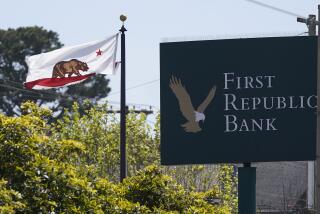THE THRIFT INDUSTRY : Seized S&Ls; Run Up Big Deficit; Fraud at Many
- Share via
WASHINGTON — The insolvent savings and loan associations seized by the government since February have accumulated massive losses of $29.8 billion, and serious cases of fraud have been uncovered at 50 of them, the Federal Deposit Insurance Corp. said Thursday.
“These are the worst cases,” said FDIC Chairman L. William Seidman, recounting his agency’s work in analyzing the financial condition of 212 insolvent thrift institutions.
Seidman predicted that the $50 billion requested by President Bush would be sufficient to pay depositors and complete the sale or shutdown of all 279 crippled S&Ls; on the government’s danger list. However, he admitted that higher interest rates could drive additional institutions, now healthy, into insolvency, increasing the need for rescue funds.
Meanwhile, the House Ways and Means Committee gave final approval Thursday to its portion of the S&L; rescue legislation and adopted an amendment requiring the industry to contribute an additional $600 million. The bill, passed by a vote of 26 to 10, would include the cost of the S&L; rescue in the federal budget, despite the threat of a veto by President Bush.
Seidman’s status report provided a detailed look at the severity of the crisis at the most troubled institutions, and he emphasized the need for Congress to act quickly to approve the bailout legislation.
FDIC personnel took control of the 212 institutions and completed an intensive review of the financial health of each S&L.;
They discovered that the troubled thrifts have assets of $73.4 billion, including billions of dollars in bad loans on real estate--land, office buildings, shopping centers, single-family homes and apartment buildings. If the S&Ls; were closed tomorrow, their assets sold and the depositors paid off, the losses would total $29.8 billion. This represents the amount required from the federal insurance fund that guarantees S&L; deposits up to $100,000.
But the insurance fund is broke, and money will not be available to close the S&Ls; and pay the depositors until Congress passes the rescue legislation. In many cases, the S&Ls; are offering above-market interest rates to attract funds they need to stay in business. The rescue legislation, which has already been approved by the Senate, would cost about $157 billion over 10 years, with the taxpayers responsible for about 75% of the outlays and the S&L; industry paying the balance. Bonds will be issued to provide the funds to dispose of the crippled thrifts.
While action is pending, deposits continue to drain from S&Ls;, prompted by a combination of nervousness and the attraction of higher rates offered by money market funds, an alternative investment.
Seidman’s report, which covers the period up to April 15, did not include losses for two Southern California S&Ls;, Gibraltar Savings and Lincoln Savings, which have since been placed under FDIC control. These institutions have combined assets of $20.4 billion.
Thursday’s interim report “shows that concrete progress has been made in reducing losses and preparing to structure permanent solutions . . . when President Bush’s S&L; legislation is enacted,” Seidman said.
FDIC managers at the seized S&Ls; have cut monthly operating expenses by $13.6 million, primarily by cutting payrolls.
A special fraud squad has “uncovered potential criminal violations in about 50 S&Ls;, resulting in criminal referrals to the Department of Justice,” according to the FDIC report. Frequently, the violations involve actions by previous owners or managers of the S&Ls;, who were involved in real estate projects doing business with the thrifts.
As many as one-third to half of the 212 S&Ls; have fraud problems, including cases previously uncovered by federal regulators and referred for prosecution. The report Thursday dealt only with the fraud uncovered since FDIC took control of the financial institutions, beginning in February.
The Ways and Means Committee gave its final approval for a financing method dependent on the sale of Treasury bonds to provide the $50 billion needed to close insolvent institutions. The $50 billion would be counted as part of budget spending but would not count against the budget limits in the Gramm-Rudman-Hollings law, which mandates a balanced budget by 1993.
The Administration wanted to pay for the outlays through sales of special bonds--bearing higher interest rates--that would not be counted as part of the federal budget, a proposal approved by the Senate.
But Ways and Means members insisted on on-budget financing, although the White House threatens a veto if this technique is included in the final legislation sent to the President.
The committee approved an amendment requiring the Federal Home Loan Bank system to contribute $600 million in 1991 and 1992 to the S&L; rescue package. The bank system is owned by the S&Ls;, and the amendment increases the financial burden on the industry. After 1992, the annual contribution of $300 million annually would be indexed to keep pace with the rate of inflation.
The committee rejected a plan to pay for the S&L; insurance fund rescue by raising taxes.
“We’ve got garbage, and none of us wants to carry it out,” said Rep. Sam M. Gibbons (D-Fla.), who proposed a 1.5% surtax on businesses and individuals. “So what we’re saying is that our children and grandchildren are going to carry it out. That’s just morally and ethically wrong.”
More to Read
Inside the business of entertainment
The Wide Shot brings you news, analysis and insights on everything from streaming wars to production — and what it all means for the future.
You may occasionally receive promotional content from the Los Angeles Times.









